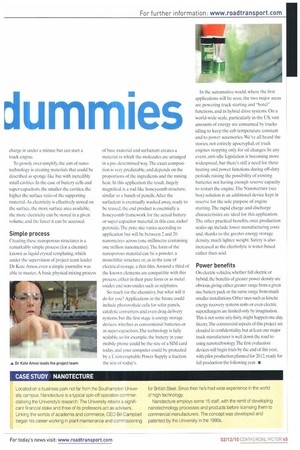Chemistry fo
Page 44

Page 45

If you've noticed an error in this article please click here to report it so we can fix it.
A small, business in Hampshire is preparing to revolutionise the way that the electrical systems on trucks throughout the world are powered
Words: Colin Barnett When we were invited to visit the environs of Southampton University to learn more about nanotechnology, we weren't exactly convinced of the relevance. When a presentation started explaining the basic principles of surfactants and how soap works to remove dirt, it brought back vague memories of CSE Chemistry (failed) but did little more to relate to trucks. But we hung on, and so should you, because this technology will be in your yard sooner than you think.
• Before getting into the chemistry, it may help to identify the answer to which nanotechnology is the question. There are many applications for this newish science, but the one that interests us at the moment is achieving a significant increase in the power density of electric storage devices. Think of a box smaller than a paperback book that can charge in under a minute but can start a truck engine.
To grossly over-simplify, the aim of nanotechnology is creating materials that could be described as sponge-like but with incredibly small cavities. In the case of battery cells and super-capacitors, the smaller the cavities, the higher the surface ratio of the supporting material. As electricity is effectively stored on the surface, the more surface area available, the more electricity can be stored in a given volume, and the faster it can be accessed.
Simple process
Creating these nanoporous structures is a remarkably simple process (for a chemist) known as liquid crystal templating, which under the supervision of project team leader Dr Kate Amos, even a simple journalist was able to master, A basic physical mixing process of base material and surfactant creates a material in which the molecules arc arranged in a pre-determined way. The exact composition is very predictable, and depends on the proportions of the ingredients and the mixing heat. In this application the result, hugely magnified, is a rod-like honeycomb structure, similar to a bunch of pencils. After the surfactant is eventually washed away, ready to be reused, the end product is essentially a honeycomb framework for the actual battery or super-capacitor material, in this case, nickel peroxide. The pore size varies according to application but will be between 2 and 20 nanometres across (one millimetre containing one million nanometres), The form of the nanoporous material can be a powder, a monolithic structure or, as in the case of electrical storage, a thin film. Around a third of the known elements are compatible with this process. either in their pure form or as metal oxides and non-oxides such as sulphates.
So much for the chemistry, but what will it do for you? Applications in the future could include photovoltaic cells for solar panels, catalytic converters and even drug delivery systems, but the first stage is energy storage devices. whether as conventional batteries or as super-capacitors.The technology is fully scalable, so for example, the battery in your mobile phone could be the size of a SIM card today, and your computer could be protected by a Uninteruptable Power Supply a fraction the size of today's. In the automotive world, where the first applications will be seen, the two major areas are powering truck starting and "hotel" functions, and in hybrid drive systems. On a world-wide scale, particularly in the US, vast amounts of energy are consumed by trucks idling to keep the cab temperature constant and to power accessories. We've all heard the stories, not entirely apocryphal, of truck engines stopping only for oil changes. In any event, anti-idle legislation is becoming more widespread, but there's still a need for these heating and power functions during off-duty periods, raising the possibility of existing batteries not having enough reserve capacity to restart the engine. The Nanotecture (see box) solution is an additional device kept in reserve for the sole purpose of engine starting. The rapid charge and discharge characteristics are ideal for this application. The other practical benefits, once production scales up, include lower manufacturing costs and, thanks to the greater energy storage density, much lighter weight. Safety is also increased as the electrolyte is water-based rather than acid.
Power benefits
On electric vehicles, whether full electric or hybrid, the benefits of greater power density arc obvious, giving either greater range from a given size battery pack or the same range from much smaller installations Other uses such as kinetic energy recovery systems units or even electric superchargeis are limited only by imagination. This is not some airy-fairy, might happen one day, theory. The commercial aspects of this project are clouded in confidentiality, but at least one major truck manufacturer is well down the road to using nanotechnology. The lirst evaluation devices will begin trials by the end of this year, with pilot production planned for 2012, ready for full production the following year. •
































































































































